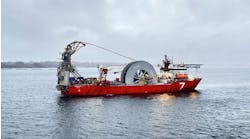Baltic Sea pipeline system will be cathodically protected by zinc and aluminum alloy sacrificial bracelet anodes
Rogelio E. Garza
James Lenar
Galvotec Alloys Inc.
By now, the offshore industry has become familiar with the record-breaking Nord Stream pipeline project. It involves the design and construction of two 760-mi, 48-in. pipelines that each will carry 27.5 bcm/yr (971 bcf/yr) of natural gas from Russia to Europe via the Baltic Sea starting later this year. That capacity will be expanded to 55 bcm/yr (1.94 tcf/yr) when the second line is placed in service in 2012.
Installation of first pipeline is nearing completion; and to date, more than 83,300 segments of pipe have been laid over a distance of more than 1,000 km (621 mi) in the Baltic Sea. Allseas’Solitaire has finished its installation work for one section of the offshore line, and Saipem’s Castoro Sei is expected to complete the larger part of this first pipeline this month.
These facts are well known to the offshore oil and gas industry. What is less well known is that an American company, Galvotec Alloys Inc. of McAllen, Texas, was chosen to manufacture sacrificial aluminum and zinc anodes that will protect Europe’s longest underwater pipeline from corrosion.
The Nord Stream pipeline is setting benchmarks and milestones unmatched by any other pipeline project in history. The materials supply and logistics involved with a project of this magnitude are without parallel. The pipeline has been built for a design life of 50 years. The Baltic Sea environment is unique, and salinity and temperatures vary significantly throughout the year. The pipeline depth ranges between 0 and 722 ft (210 m). As noted, the pipeline will be cathodically protected by a combination of zinc and aluminum alloy sacrificial bracelet anodes.
From the anode manufacturer’s perspective, this project posed numerous challenges. The anode manufacturing phase lasted for approximately 15 months. During that period, over 20,000 anode bracelet halves were produced with an alloy weight of over 12 million lb (5.4 million kg). A total of over 5,000 individual heats (lots) were produced. The largest individual anode weights produced were over 1,000 lb (454 kg) for the aluminum semi-cylindrical bracelets, and over 2,600 lb (1,179 kg) for the zinc semi-cylindrical bracelets.
Sacrificial bracelet anodes typically are either a zinc alloy or an aluminum alloy, depending on the design requirements, environmental variables, and water salinity. Both alloy types were used in the fabrication of the anodes for Nord Stream. Sacrificial bracelet anodes, as a true and tested component, are cost effective and reliable for the cathodic protection of submerged pipelines. These pipelines usually have an anti-corrosion coating and along with a heavy concrete mix for negative buoyancy. Bracelet anodes are mounted in specific locations determined by the cathodic protection system design, and are connected electrically to the pipeline via special bonding copper cables.
The main defense that the pipeline has against corrosion is the anti-corrosion coating. The bracelet anodes are designed to protect the pipeline where any voids, pits, or other coating failures may occur during installation or during the operating life of the pipeline.
From a quality viewpoint, the project was a massive undertaking. Before the anode manufacturing could begin, a pre-qualifying audit was performed that involved a team of experts from Nord Stream and Det Norske Veritas. The anode design was reviewed and a complete inspection and test plan (ITP) was structured according to the project’s requirements and procedures, which were considerably more stringent than those normally used. The Baltic Sea is a sensitive environmental area, and no efforts could be spared to ensure the efficiency of the pipeline’s protection against corrosion.
Sacrificial bracelet anodes installed on Nord Stream pipe joints.
During the pre-production phase, every aspect of the manufacturing process was monitored, reviewed, and approved. Every production piece was analyzed and tested according to Galvotec’s quality management system, including the rigorous destructive testing that required the dissection of actual production pieces to inspect for internal flaws and defects. The anode’s tight dimensional tolerances, shape, and weight were carefully monitored as critical component characteristics.
Procedures for every step of the manufacturing process were submitted and reviewed for approval, and then the process was continuously inspected for compliance.
Packaging and shipping requirements also were demanding, and included project-specific pallet fabrication to ensure that the anodes were properly bundled and secured for the journey by ocean carrier to Germany and Finland. A color coding system was required to ensure every anode was matched properly to the pipe section it was designed to protect.
Supply chain logistics were another challenge. Raw material supplies included high purity aluminum and zinc, steel for the anode cores, welding materials and supplies, cables and lugs, pallet suppliers, coating materials, shipping and export agents. Shipping all of these materials had to follow an organized and controlled scheduling system. All of these pieces had to come together like clockwork due to the unusually large volume of material that moved through the production process every day for the duration of the project.
Both local and international raw material suppliers had to meet the requested delivery deadlines while also meeting the challenging documentation requirements. Meticulous financial planning also was required to support the project throughout the length of its cycle, which included up to eight weeks in transit to the pipe fabricator. A complex, project-specific database had to be developed to monitor the entire process in real time. The entire manufacturing and quality process was inspected and certified by DNV. The final data books for the project required over 13,000 pages.
For Galvotec, milestones in anode manufacturing achieved on the Nord Stream project included:
- The largest semi-cylindrical bracelet anode diameter ever manufactured
- The heaviest zinc bracelet anode ever manufactured
- The second heaviest aluminum bracelet ever manufactured
- The most stringent anode specification requirements known in the industry
- The largest volume of anodes produced for one single order
- The heaviest single anode order
- The largest volume of shipping containers used for an anode project.
As immense as the project seemed, the Galvotec team of experienced professionals and foundry-men rose to the challenge. Together, they met the most stringent requirements in the industry while producing the highest quality product, delivering it ahead of schedule, and within the original budgeted price.
Offshore Articles Archives
View Oil and Gas Articles on PennEnergy.com






